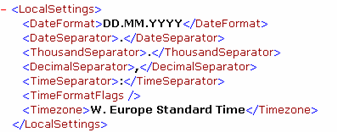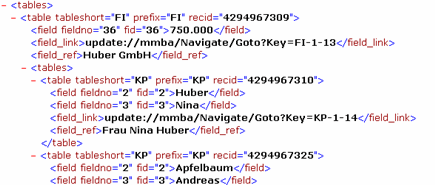XML Format
The XML output contains information on the version of Aurea.CRM used as well as the data stored in the fields selected in the transfer fields format.
The start of the XML output contains the version-specific information:

|
Vertical |
The vertical used |
|
Version |
The version of Aurea.CRM used |
|
LangId |
Language in use |
|
StationNo |
Station number |
|
User |
The user that generated the report |
|
Created |
Date and time of creation (YYYYMMDDThhmmm) |
|
Formatname |
Name of the report format |
This is followed by the current regional settings:

|
DateFormat |
Date format (D = Day, M = Month, Y = Year) |
|
DateSeparator |
Date separator |
|
DateFormatFlags |
Only output if the year is specified using only 2 digits |
|
ThousandSeparator |
Thousands separator |
|
DecimalSeparator |
Decimal separator |
|
TimeSeparator |
Time separator |
|
TimeFormatFlags |
Time format (AM/PM or empty for 24 hour format) |
|
Timezone |
Current time zone |
This is followed by a list of the fields stored in the report:

|
tableshort |
The abbreviation of the info area from which the field is taken |
|
tablename |
The name of the info area from which the field is taken |
|
fieldno |
The number of the field |
|
fid |
Fixed field number |
|
fieldname |
The name of the field |
|
fieldlength |
The length of the field in characters |
|
fieldtype |
The field type, see Data types in Aurea.CRM in the CRM.core Administrator Guide. |
This is followed by the actual data from within Aurea.CRM:

|
tableshort |
The abbreviation of the info area |
|
prefix |
The field prefix of the info area (transferred from the transfer fields format; Extras à Define Transfer Fields > Select an info area > Edit > Info Area tab > Field Prefix field). If an info area is transferred multiple times per report, the prefix is complemented by a serial number (e.g. FI, FI1 etc.). |
|
recid |
The record's ID |
|
fieldno |
The field number |
|
fid |
Fixed field number |
|
catNo |
Contains the catalog number if the field is a catalog field |
|
catval |
Contains the catalog value if the field is a catalog field |
|
parCatVal |
Catalog value of the parent catalog (only for dependent catalogs) |
|
field_link |
Contains the address for links, if Output Links is enabled |
|
Languages |
Sub-node: language used |
|
Catalogs |
Sub-node: Catalog values used in the report. Catalog type: K = catalog, x = fixed catalog in Aurea.CRM win, o = fixed catalog in Aurea.CRM web)catNo: Catalog numbercatval: Catalog valuemnr: Tenant number langId: ID of the language used extKey: External key of the catalog value Only for dependent catalog values: ParCatVal: Parent catalog value ParCatNo: Number of the parent catalog ParCatExtKey: External key of the parent catalog value |
Special Case: The Result field in the Communication Logs info area stores a combination of values from several columns in the info area, see Communication Logs in the Aurea.CRM win Administrator Guide. These are output as multiple attributes in an XML report.

|
Attribute |
Column in the Communication Logs info area |
|---|---|
|
input |
Recs |
|
insert |
New |
|
Aurea |
Upd |
|
delete |
Delete |
|
false |
False |
|
similar |
Sim F. |
|
denied |
Denied |
|
output |
Out |
|
sync |
Synchronization |
|
basedate |
Base Date |
|
basetime |
Base Time |
|
match |
Match |
Special Case: History records are output in a BLOB (Binary Large Object), see History in the CRM.core Administrator Guide. To output history records in an XML report, add one or more of the following virtual fields to the transfer fields format: ID, Stat.No., Date, Time, Rep ID, Rep, Windows User Name, Windows computer name, Version, Module, Field Number, Field Name, Old Value, New Value, Time Zone.
The history records are output below the <tables> node of parent records. The selected fields are output for each field change below the <tables> nodes of the history records. No history is output in the report for fields in the parent record that the current user cannot access due to their access rights.